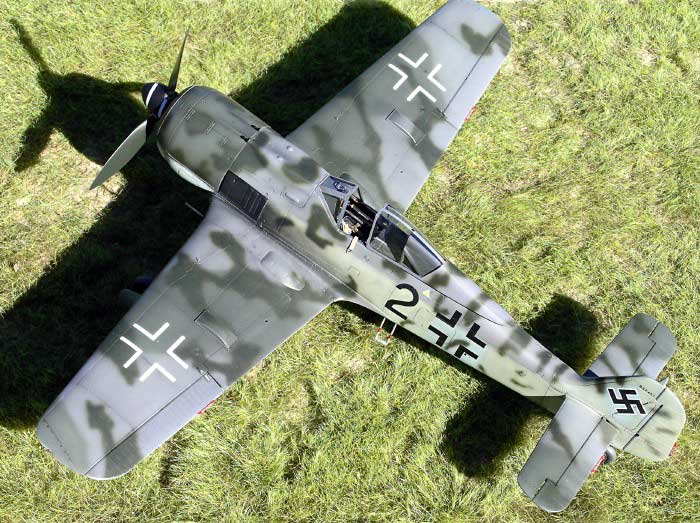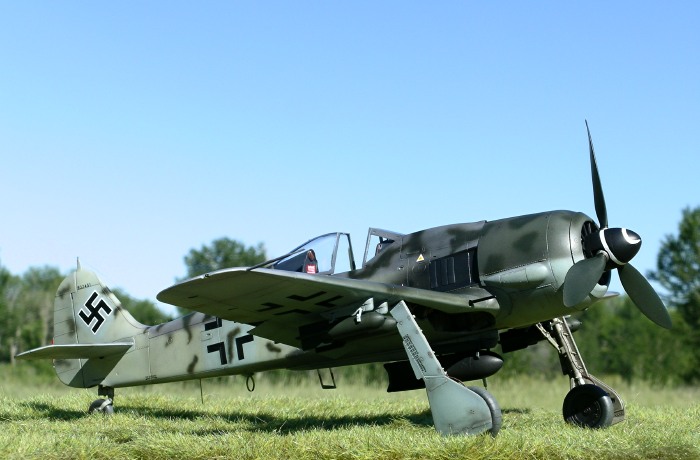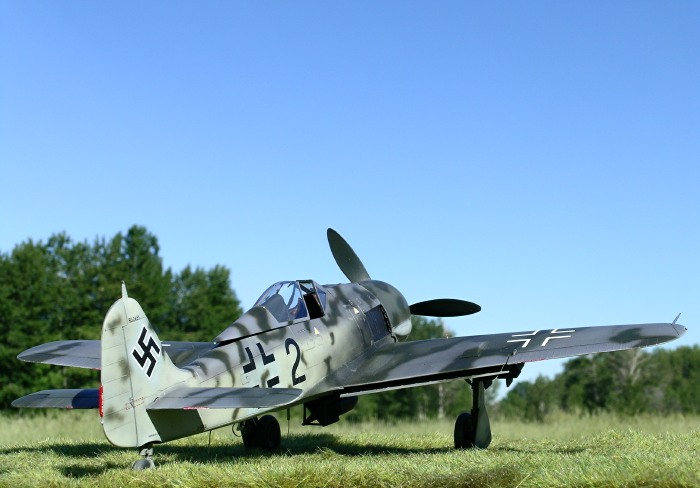|
Hasegawa's 1/32
scale
Focke-Wulf Fw
190F-8
by
Ian Robertson
|
 |
|
Focke-Wulf Fw 190F-8 |

Hasegawa's
1/32 scale Focke-Wulf Fw 190F-8
is available online from Squadron.com
The Focke-Wulf Fw.190F-8 served as a ground attack counterpart to the
Fw.190A-8. In most respects the F-8 was identical to an A-8, but with
its outboard cannons removed and the ETC 501 fuselage rack as standard.
Many late F-8s had the “blown hood” style canopy whereas this was less
common on A-8s. The outboard upper-wing plate associated with the
deleted cannon often remained present.
Hasegawa has released an F-8 version based on their popular new-tool
1/32 Fw.190A-8 kit. Differences from the A-8 kit include the blown hood
(as well as the flat hood), proper underwing panels for the F-8,
underwing bombs (as in the Fw.190D-9 “Rudel” kit), and a resin SC250
centerline bomb.

The F-8 kit is substantially more expensive than the A-8 kit. It is
worth noting that one could build an F-8 using the A-8 kit and the extra
parts supplied in the Fw.190D-9 “Rudel” kit. You would still have the
parts needed to build a D-9 with a flat hood. The only part lacking
would be the resin bomb supplied in the F-8 kit.
Here I present “Black 2”, a Fw.190F-8 in the unique late-war markings of
an aircraft from SG77 found at Chrudim, Czechoslovakia in May 1945. A
photograph and color profile of the aircraft can be found on page 178 of
Bergstrom and Pegg’s “Jagdwaffe: The War in the East 1944-1945”, Volume
5(2) in the series by Classic Publications. There are no decals for this
particular aircraft in 1/32. (Cutting Edge does produce them in 1/48 -
sheet#48166, where the aircraft is identified as “Red 2”). However, the
lack of decals was a minor problem because the “2” was easy to mask and
the other markings on the aircraft are standard.
The Hasegawa Fw.190F-8 kit provides no additional challenges in
construction as compared to the A-8 kit. Numerous build reviews can be
found in the Hyperscale features section.
The modifications I made to my model included: resin seat from Cutting
Edge, lead foil belts with MDC buckles, home-made loop antenna, treads
added to kit tires, brake lines made from wire, modified tail wheel
assembly, and corrected coaming above instrument panel.

Although Hasegawa provides an option for dropped flaps, they are
engineered to be dropped at an incorrect angle for the Fw.190. The flaps
should not drop more than 60 degrees, although the kit has them dropping
at almost 90 degrees. I opted to leave mine dropped only slightly, as is
often seen for parked Fw.190s.
Painting began by preshading the panel lines and various areas of the
model in black. Additional black was added to the fuselage side where
the number “2” was to be masked. Using a photocopier I enlarged the
color profile in the Jagdwaffe book to 1/32 scale, and made a series of
repeats of the number 2 on a sheet. I then placed a piece of Tamiya tape
over the number on the sheet, cut it out with a #11 blade, and then
applied it as a mask to the model. The mask remained in place until
painting was complete.

The unique and varied camouflage scheme on this aircraft suggests
that the airframe had been recycled. Based on the color profile in the
Jagwaffe book, the sides of the fuselage exhibit the original bluish
RLM76 beneath the national markings, with an overspray of “straw
colored” RLM76. The upper wings appear to be the standard RLM74/75
pattern for a Fw190 but with additional dark patches of RLM83 green.
Patches of RLM83 also appear on the fuselage.
 I
attempted to create a camouflage pattern consistent with the color
profile in the Jagdwaffe book. The upper wing patterns are based
partially on what I could discern from the photograph in the book, and
the starboard fuselage is my own interpretation. I used Polly Scale
acrylic for the RLM74/75/76 (bluish), and Tamiya’s IJA grey (XF-14) with
a touch of white for the straw-color RLM76. I
attempted to create a camouflage pattern consistent with the color
profile in the Jagdwaffe book. The upper wing patterns are based
partially on what I could discern from the photograph in the book, and
the starboard fuselage is my own interpretation. I used Polly Scale
acrylic for the RLM74/75/76 (bluish), and Tamiya’s IJA grey (XF-14) with
a touch of white for the straw-color RLM76.
The spinner was painted white and then masked with a curved strip of
Tamiya tape for the spiral. I then painted the spinner black.
This spiral on the spinner is speculative as the spinner is not
visible in the photograph. The propeller blades were painted RLM70
(black green) using Polly Scale acrylic.

The cockpit was painted RLM66. Wheel wells and internal surfaces of
flaps were painted RLM02.
Once the paint was thoroughly dry, I sprayed a thin coat of Future floor
wax over the model to give it a glossy finish in preparation for decals.
Most of the decals I used were from spare Eaglecals sheets. I used
Microsol to help snuggle the decals into the panel lines and rivets.
Once the decals had dried I applied a second coat of Future, followed a
day later by a 50/50 mixture of Polly Scale clear satin and clear flat.
The work number was done using dry transfers.
Groundwork
A wooden cutting board was used as the base for the model. Celluclay
was used to make the basic ground cover. The celluclay powder was mixed
into a paste with water and white glue, tinted with brown acrylic paint,
and then spread thinly over the cutting board. Note that the cutting
board had previously been treated with several coats of clear lacquer to
prevent warping while the celluclay dried. While the celluclay was still
wet I added pieces of Heki grass mat (item # 1574 - Wild Grass Savanna).
Heki products are available for purchase in the United States at “Scenic
Express”.
Images were taken with a Nikon Coolpix 5400 digital camera. The "sharpen
edges" tool of Adobe Photoshop was used to restore some of the clarity
and crispness lost during image compression.
Click on the thumbnails
below to view larger images:
Focke-Wulf Fw 190
Modelling Manuals 20 |
|
|
|
|
US Price: $17.95
UK Price: £12.99
Publisher:
Osprey Publishing
Publish Date:
May 25, 2002
Details: 64 pages; ISBN: 1841762687 |
|
|
Model, Images and Text Copyright ©
2005 by Ian Robertson
Page Created 02 August, 2005
Last Updated 01 August, 2005
Back to HyperScale
Main Page
|
Home
| What's New |
Features |
Gallery |
Reviews |
Reference |
Forum |
Search